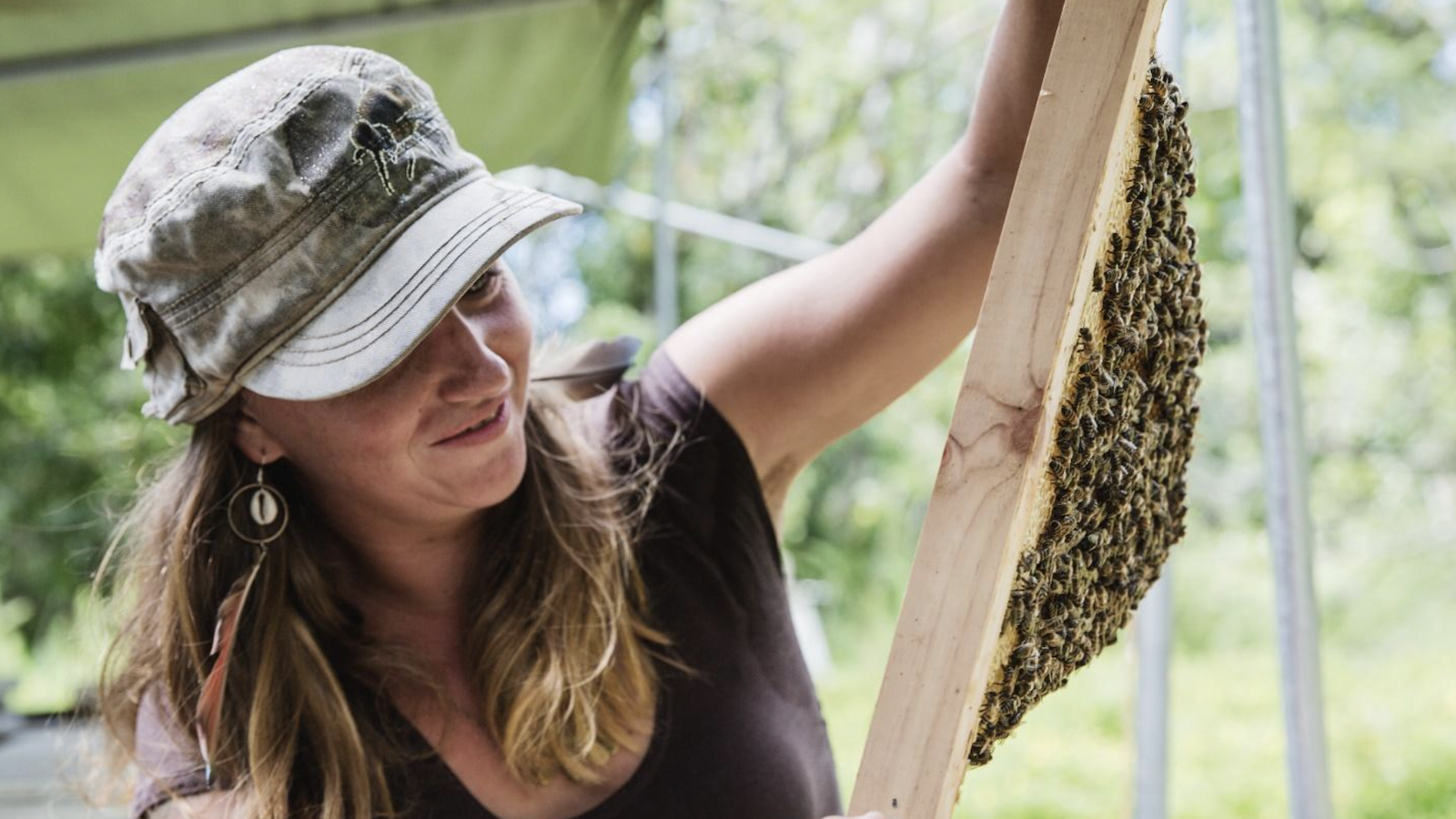On a verdant sanctuary located on Hawaii’s Big Island, Jen Rasmussen Lair, owner of Paradise Nectar Apiaries, greets one of her hives as hundreds of bees cover her bare hands. Working unprotected is a practice she has grown into throughout her years of beekeeping.
By being intent on cultivating a genuine relationship with the bees and opening to the possibility after watching another beekeeper friend work without a suit, she gradually was able to leave the preventative gear behind. She admits that the veil—the headgear that shields the face, head and neck—was the last to go.
Rasmussen Lair likens her relationship with the bees to a friendship, and says of her work, “It's my meditation to go out there and work in my hives.”
Her lush 9-acre oasis currently hosts 21 beehives—a population that she’s slowly been nursing back from the brink.
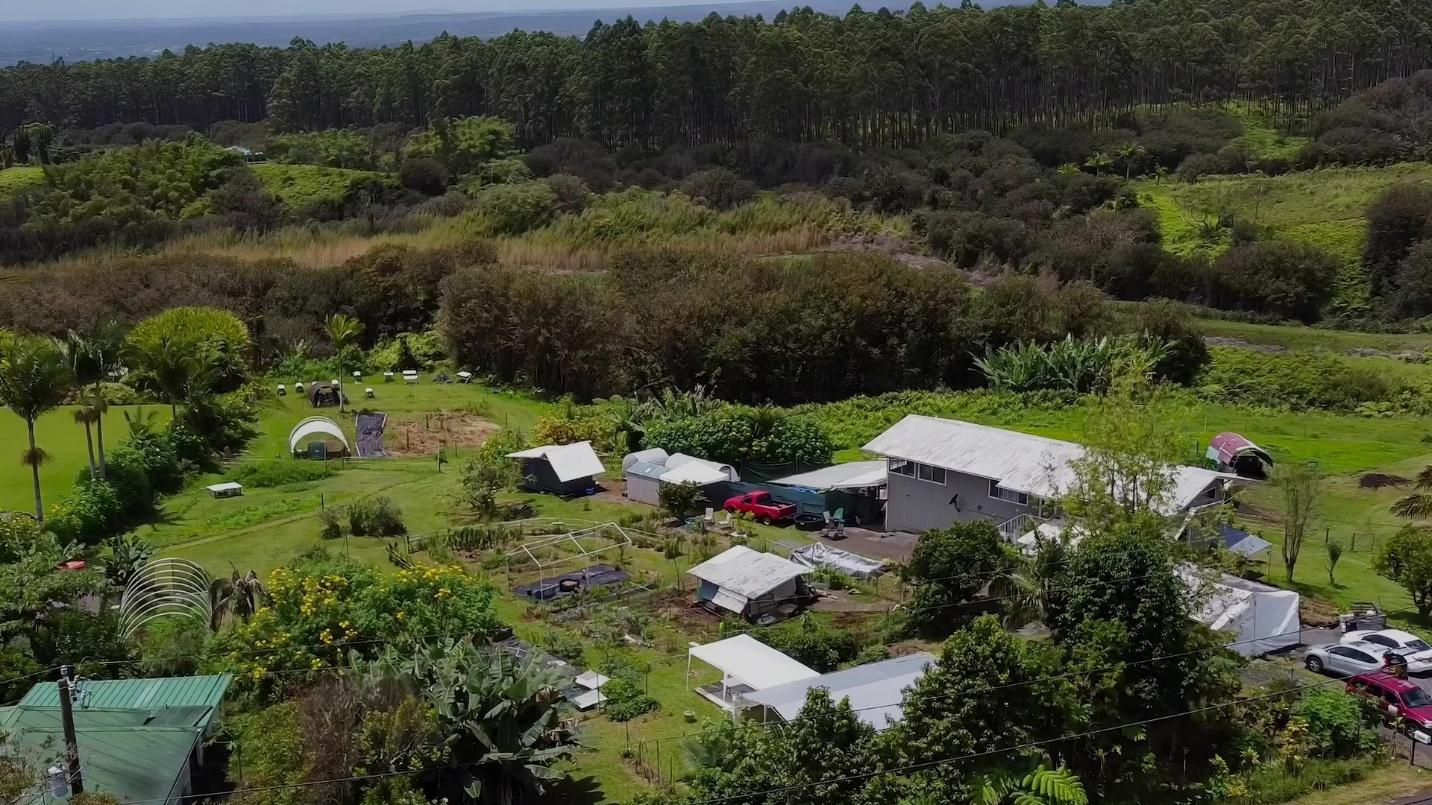
Rasmussen Lair’s property and home of Paradise Nectar. Courtesy of Jen Rasmussen Lair
She settled into her farm in Wainaku, outside of Hilo, after the 2018 lava flow claimed her previous farm in Puna—a property that she’d cultivated from scratch before the excruciating experience of watching it get covered in 20 feet of fresh rock.
Her current farm—which is home to sheep, goats, cows, chickens, pigs, dogs, cats and a tortoise—had been hosting nearly 70 hives before she began to witness a dramatic decline.
Rasmussen Lair watched as the population plummeted to just 13 hives.
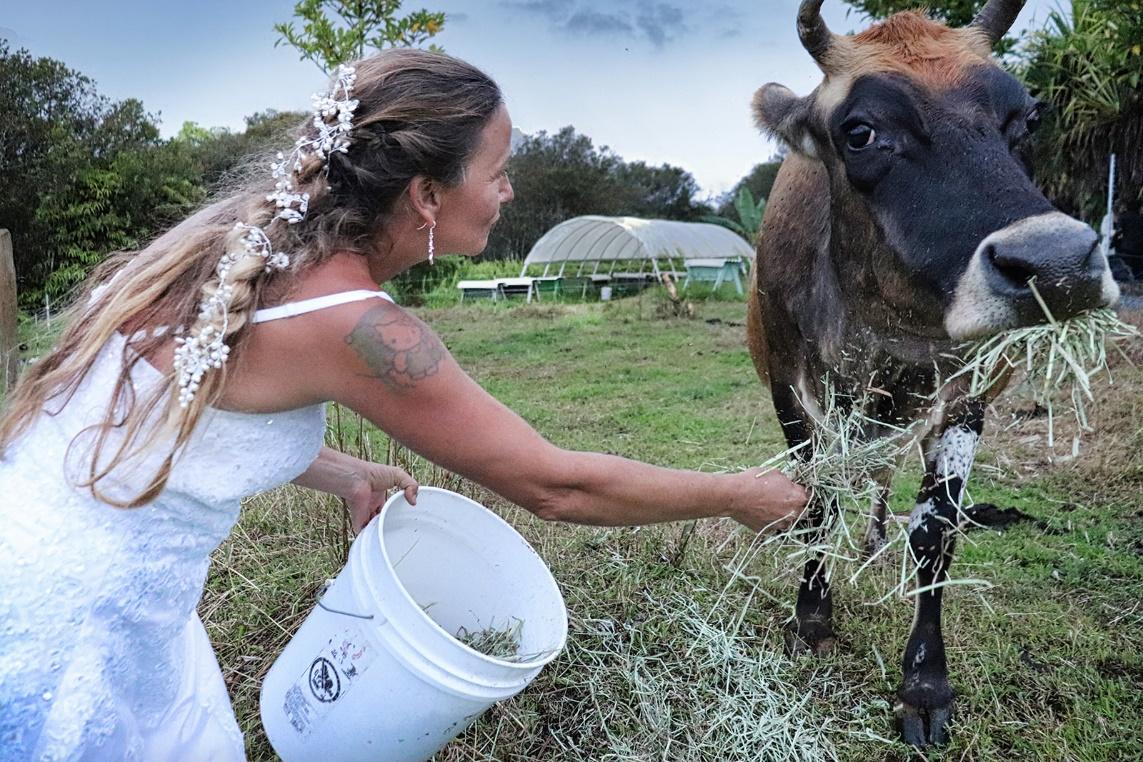
Rasmussen Lair feeding a cow on her farm. Courtesy of Jen Rasmussen Lair
Disheartening discovery
Rasmussen Lair began Paradise Nectar in 2008. In addition to maintaining her own hives, she cares for hives for individuals as well as businesses—including major macadamia nut growers on the island. She also lectures, facilitates workshops, offers hive and farm tours and teaches beekeeping classes.
In short, she’s experienced.
She knew that there must be a phenomenon that was responsible for ravaging her bee population, and it didn’t take her long to figure out what it was.
With some sleuthing, she reportedly discovered that the property adjacent to her own, that’s three times the size of her parcel, regularly sprays large amounts of herbicide in a cadence that coincides with the flowering of weeds.
Flowers—the very food that bees depend on for their survival.

A patch of dead flowers after herbicide application. Courtesy of Jen Rasmussen Lair
Studies [1][2] have shown that glyphosate, the most common agricultural herbicide, negatively impacts the gut bacteria of honey bees which compromises their immune system, making them more susceptible to diseases that can lead to death.
This is in addition to herbicides directly reducing the amount of forage that is available to bees.
While witnessing significant population decline, she also saw signs of herbicide contamination within the hives themselves.
Strange colors outside of the normal range of pigmentation were a telling sign—colors like pink, dark brown, and yellow staining.
A porous, spongy texture that isn’t found in healthy brood combs also became prevalent in the affected hives.
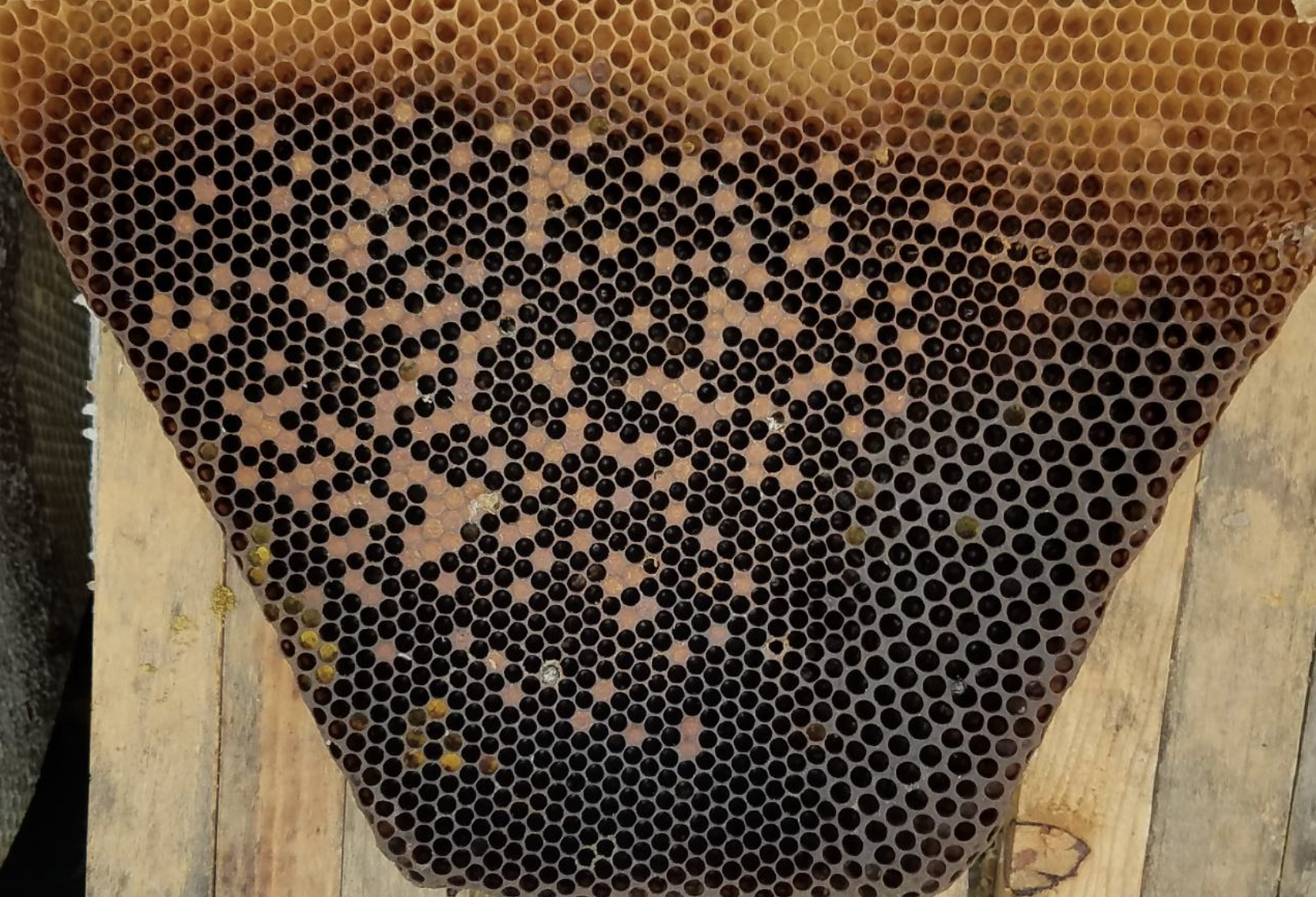
Brood comb with herbicide poisoning. Courtesy of Jen Rasmussen Lair
In addition to abnormal wax color and spongy texture, the bee bread—which is a mixture of pollen and nectar packed into combs—was giving off a strange smell.
“There is a strange sourness, almost like a rotten yogurt smell that is mixed into it when herbicide is present. If the hive gets hit really hard with herbicide, you'll smell it without even having to open the hive—it's very aromatic,” Rasmussen Lair said.
The loss and contamination have been huge blows, especially since she has worked diligently to maintain her hives without any chemical treatments since she began working with bees.
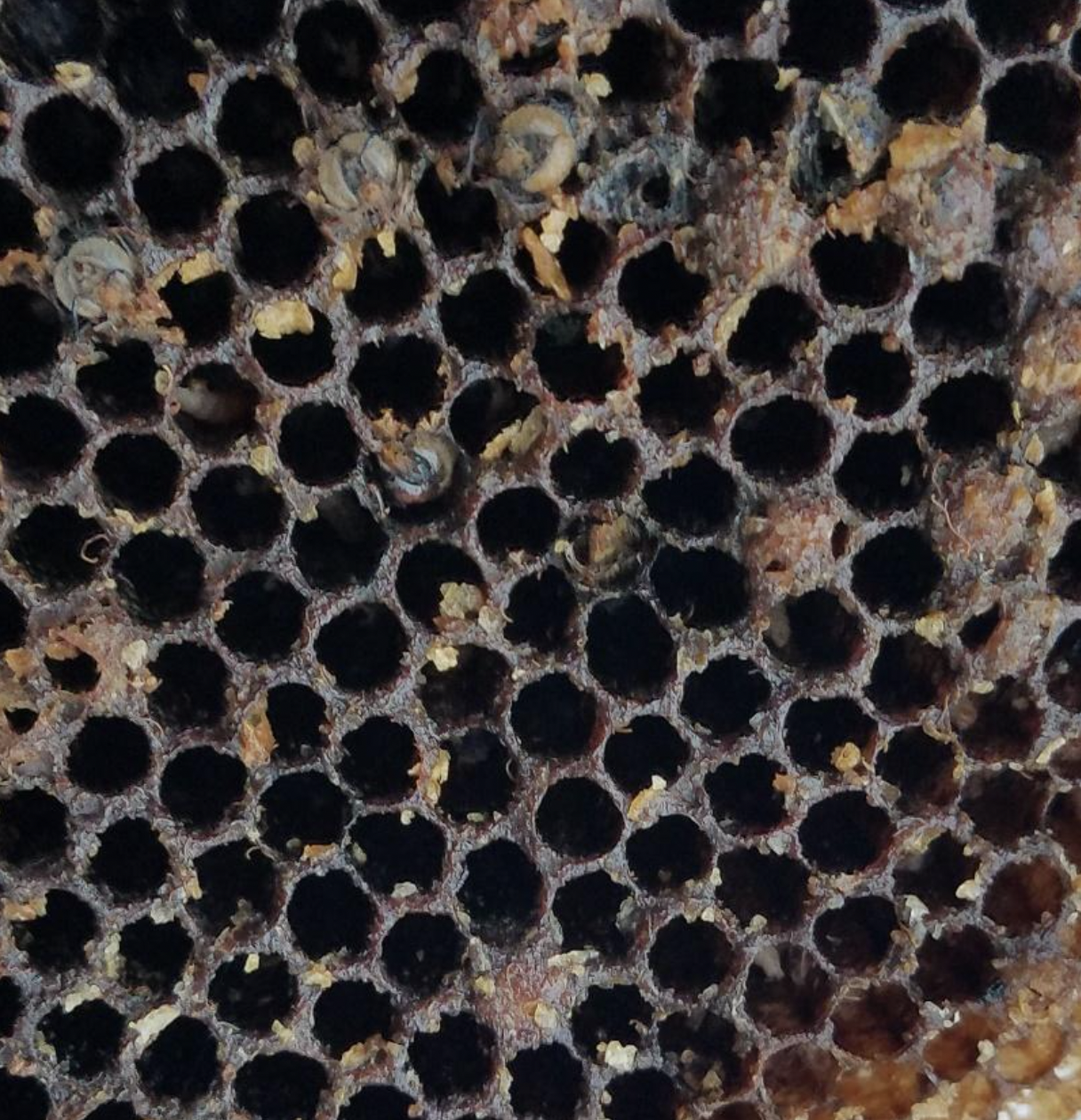 Poisoned brood comb with dead honey bees. Courtesy of Jen Rasmussen Lair
Poisoned brood comb with dead honey bees. Courtesy of Jen Rasmussen Lair
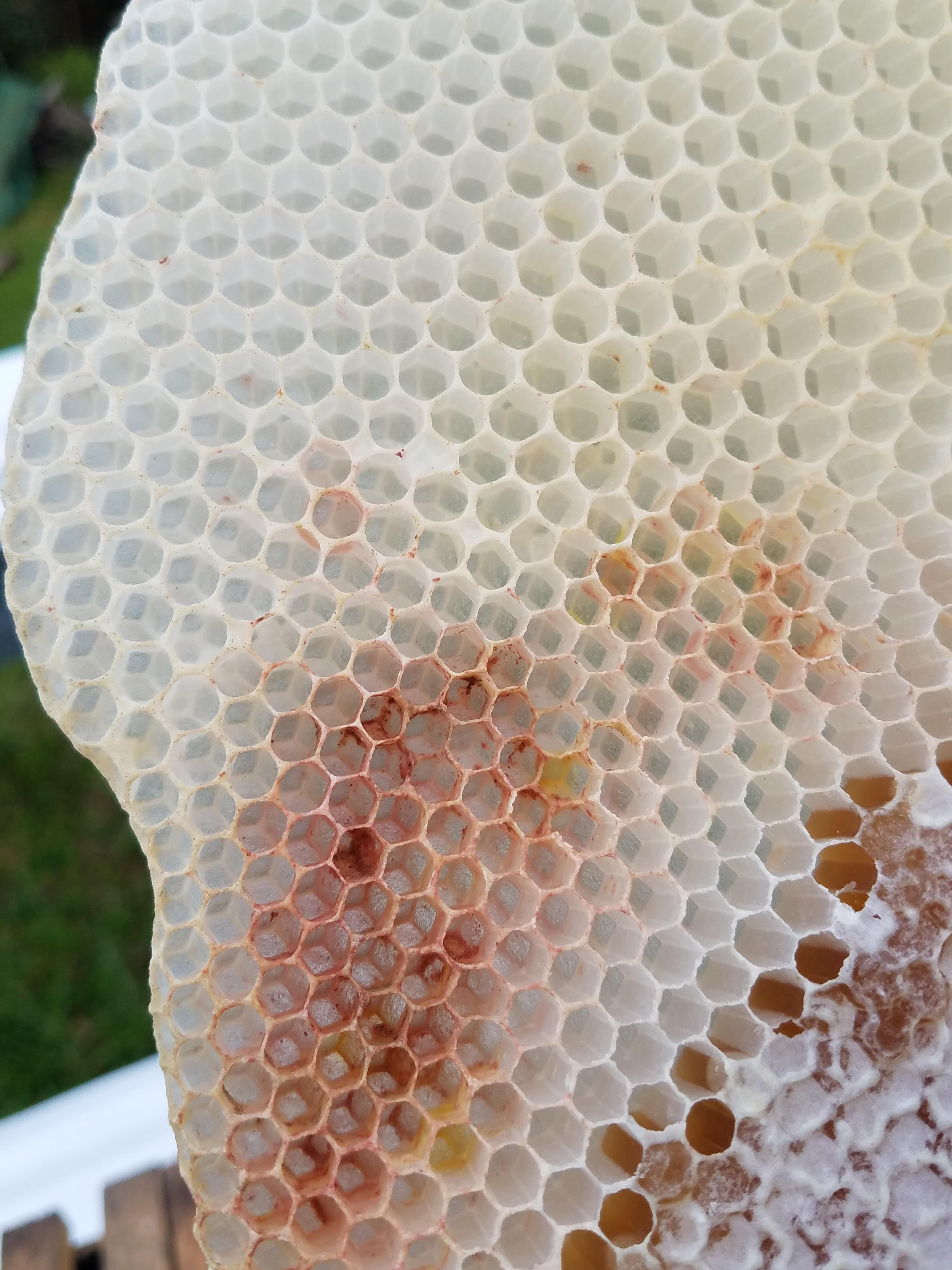
Poison stain on new honeycomb. Courtesy of Jen Rasmussen Lair
A natural approach
Paradise Nectar states that “Jen specializes in treatment-free, hygienic beekeeping, using an intuitive approach to problem solving and hive management.”
Her approach has changed over time. In the beginning she took a very hands-off approach, allowing the bees to tend to themselves, as they would in nature. However with the arrival of certain pests—most notably the varroa mite and small hive beetle—she found it necessary to be more proactive, which enabled her to manage pests while remaining treatment-free.
“I use a method called checkerboarding, which is when you put an empty bar in between two already drawn-out brood combs,” Rasmussen Lair said.
The brood comb is where the queen bee lays eggs in the hexagonal wax cells created by the bees.
The purpose of the checkerboarding method is to provide clean living space for the bees and their larvae.
She went on to explain that “By checkerboarding in the brood nest, you encourage them to make new comb. By them making new comb they have less pests, diseases, and environmental contamination in the wax. My strategy is really about foresight.”
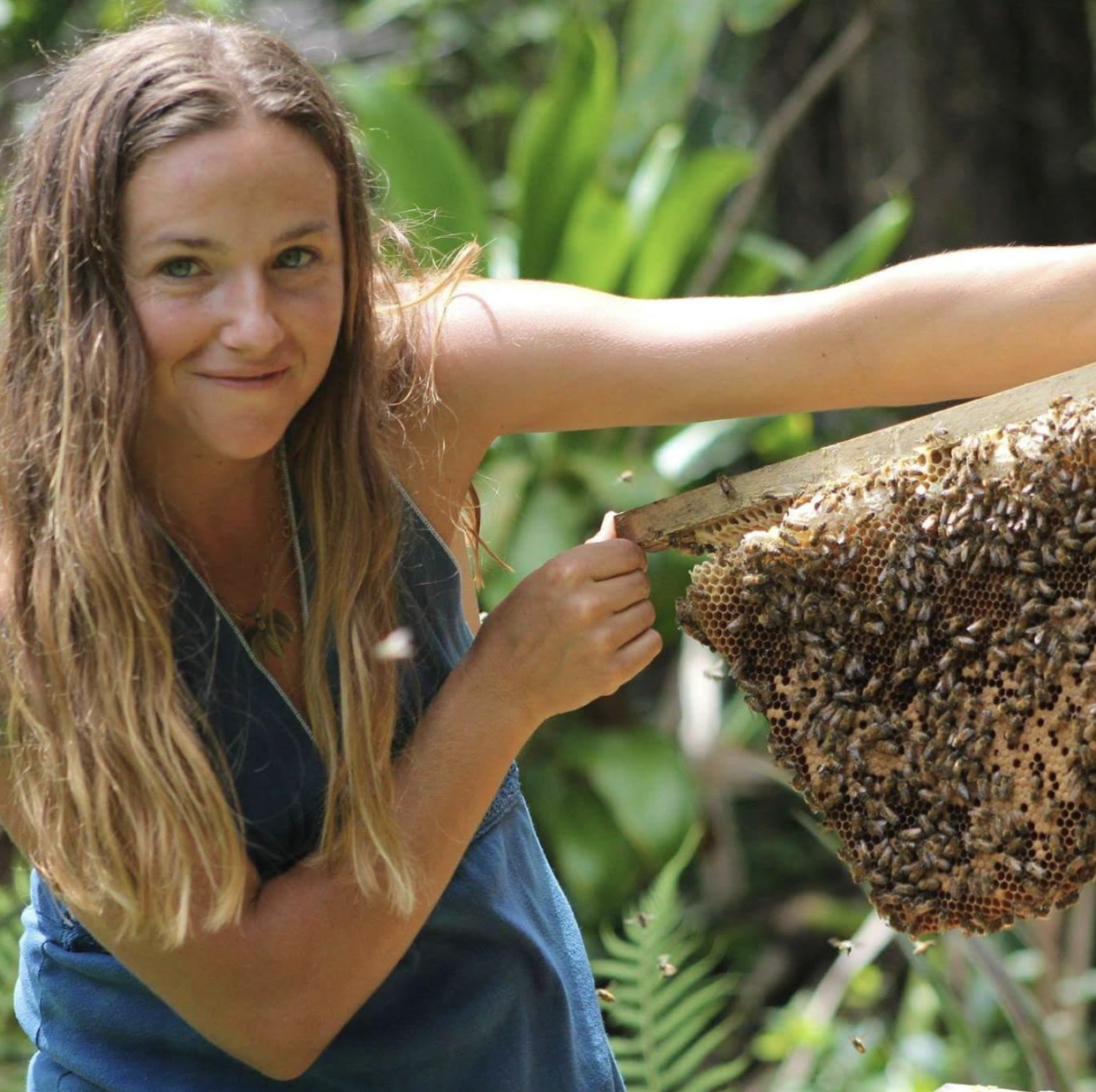
Jen Rasmussen Lair with a healthy comb and bees. Courtesy of Jen Rasmussen Lair
With her rising concern for the health of her bees and the environment at large, she reached out to her neighbors directly regarding the herbicide use. This yielded no change.
She then turned to the Health Department, the Department of Agriculture and the Environmental Protection Agency—all with no results.
From here, she took matters into her own hands in one of the only ways she felt could make a difference: she began planting flowers. A lot of flowers.
This is not a hobby or a beautification project, though the latter will come as a byproduct, but another act of foresight in caring for the bees.
In response to what she thought was most critical for the survival of bees, Rasmussen Lair said, “Growing food for people and bees. I feel like that is the new revolution. You could say I'm working on healing the world with a flower power revolution.”
While this may sound like a trite utopian aphorism, it is not.
Bees are critical to pollinating plants—including the crops that humans rely on for food—and flowers are essential to the survival of bees. Increasing the amount of available, clean forage on her own property is prudent action, especially given the loss she’s endured.
“One hive full of 50,000 [or more] bees, needs 1,000,000 blossoms at all times in order to stay healthy,” Rasmussen Lair said.
Going on to emphasize that, given that number, “There's no way that anybody's growing enough flowers,” and wants to “Encourage people to grow zinnias, cosmos, sunflowers—whatever grows easily in their environment.”
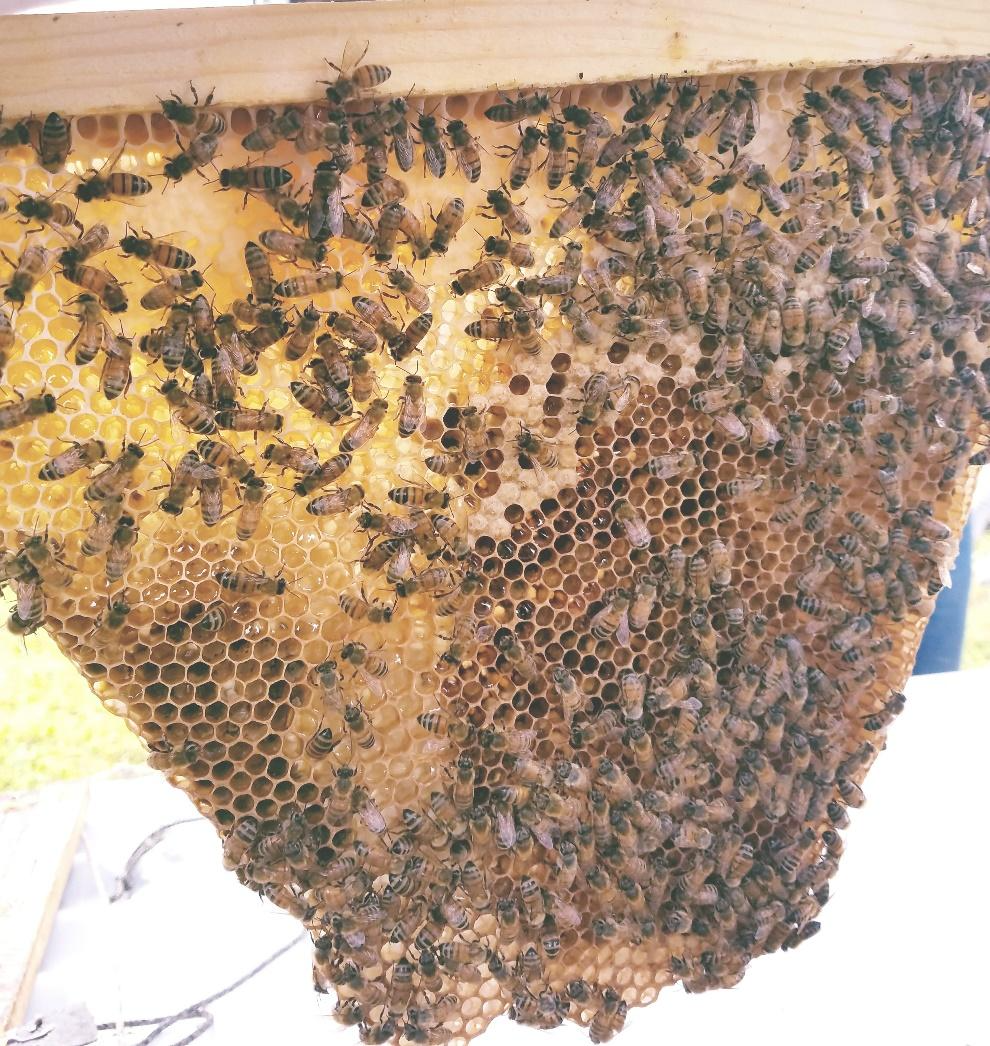
Healthy brood comb. Courtesy of Jen Rasmussen Lair
The power of education
While her own planting initiative is a vital step in assisting her own bees, the educational work that she does—which is the lion’s share of her business—holds the power to scale her efforts.
When Paradise Nectar had an abundance of hives in the past, Rasmussen Lair often sold bees and taught new beekeepers how to care for them—empowering more people to not only work with these special creatures, but also to create the necessary environment in which they can thrive.
Organic land care methods and increased planting efforts are integral lessons in her teaching model.
These days she has increased the number of retreats and workshops that she’s been facilitating—often in partnership with Jenny Bach, owner of Bee Love Apiaries and founder of the Honeybee Education Program.
These workshops are informed by ancient beekeeping methods and weave an intuitive element into the practice.
This unique approach endeavors to braid together the metaphysical and the scientific—even integrating bee biology lessons into yoga practice.
Of her approach to workshop and retreat facilitation Rasmussen Lair said, “I've always taken a more practical, scientific approach, mostly because I'm all about sustainability and being able to show that things work. I like to show people proof that there's a working model.”
“Together, our combined teaching is a really wholesome and well-rounded experience because you get the spiritual, the energetic, and how that applies to everyday living and practical application.”
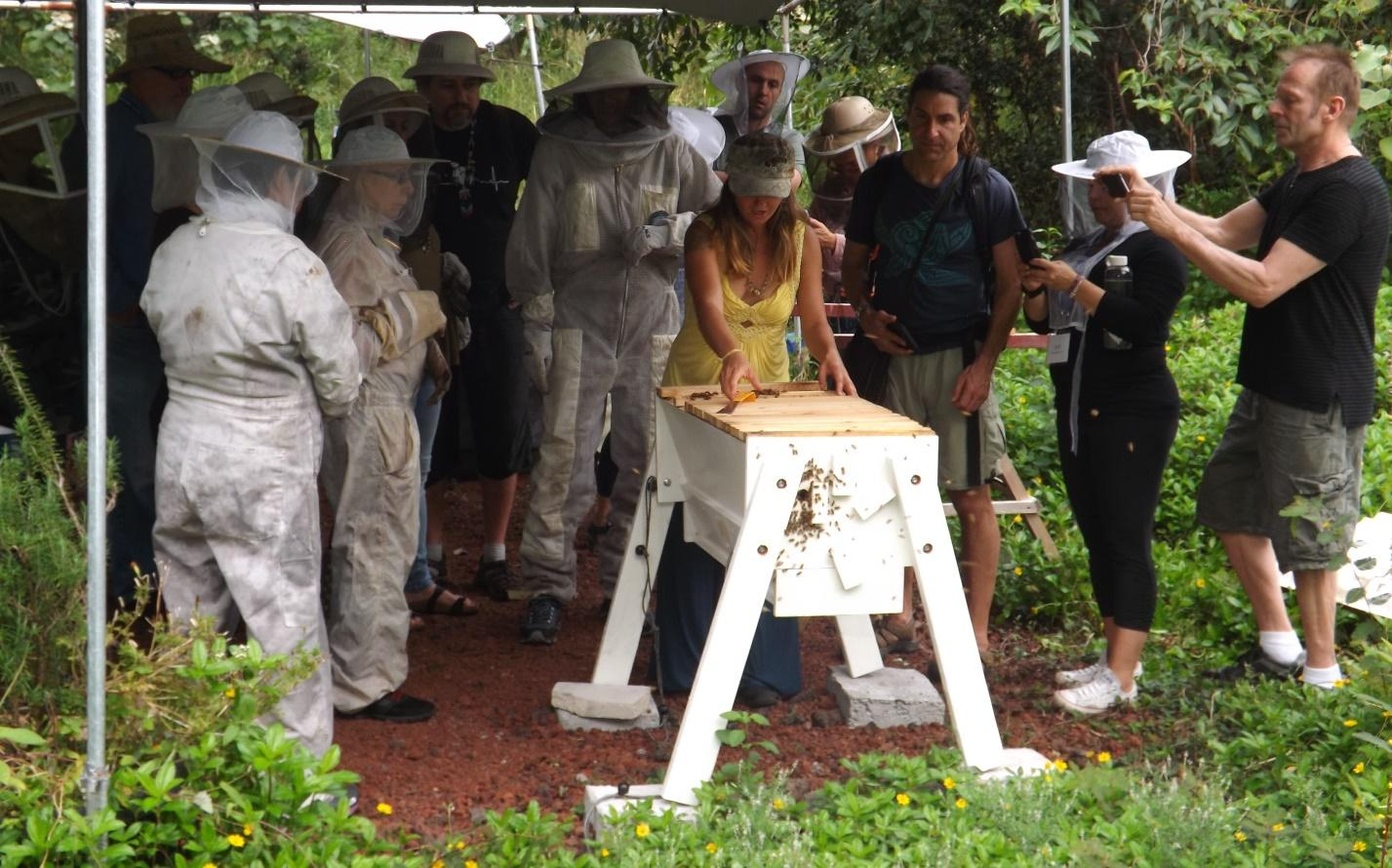
Jen teaching with a hive. Courtesy of Jen Rasmussen Lair
In looking towards the future, Rasmussen Lair is enthusiastic about bringing to life some new interactive educational opportunities, in addition to furthering her work teaching the importance of a holistic approach to beekeeping—one that honors the full cycle of connection between the land and the bees.
A key element to this is helping others get excited about getting their hands in the dirt. From her experience, she believes that it is essential for those who work with bees to help ensure safe and readily available food and habitat for them, and one of the best ways to do that is through gardening.
“I feel that it's important to show people—not just tell people but to show people—a different way. A way to live a productive and sustainable lifestyle that is fulfilling and fun. [One that] also gives back and helps nature,” she said.
“I actually want to see a better environment for all the creatures on the planet, not just humans.”
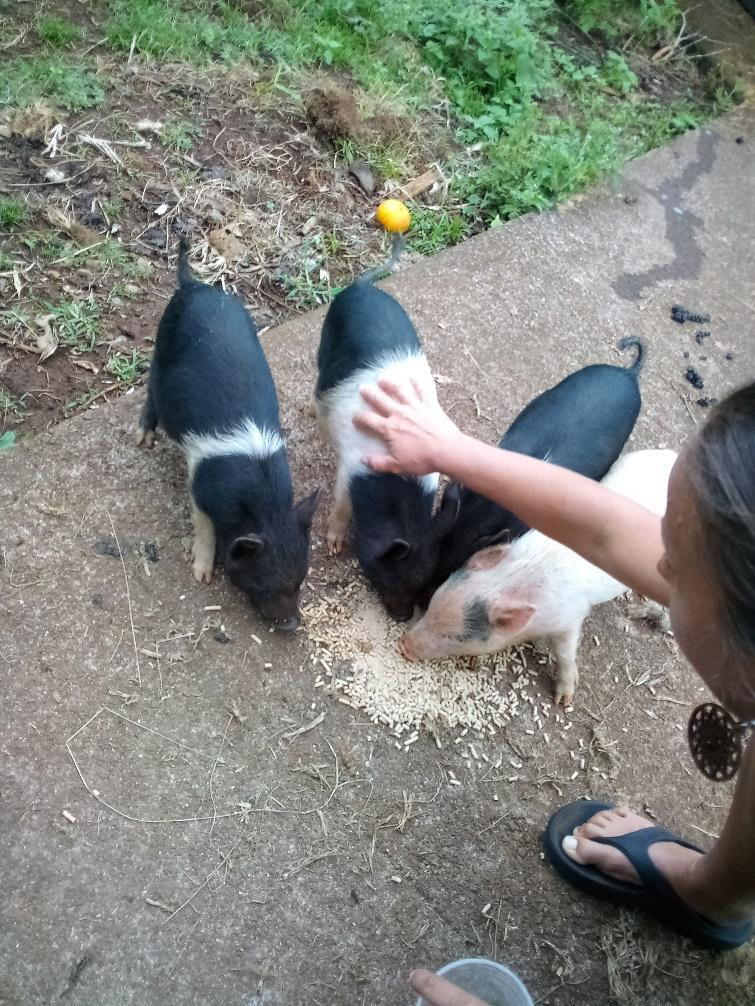
Piglets on the farm. Courtesy of Jen Rasmussen Lair
This concept that humans are somehow separate from the natural world—apart from, instead of a part of—is having cascading effects.
Most notably in climate change; undeniably in the pollution of air, water, species, and soil.
While the work of Paradise Nectar is in one remote corner of the globe, it is this type of dedication to assisting a critical species in practical ways and sharing that information that can affect change.
“I feel that somebody needs to speak for the speechless," said Rasmussen Lair. "There's a lot of injustice that's happening to the creatures large and small in the world, and I worry for them.”
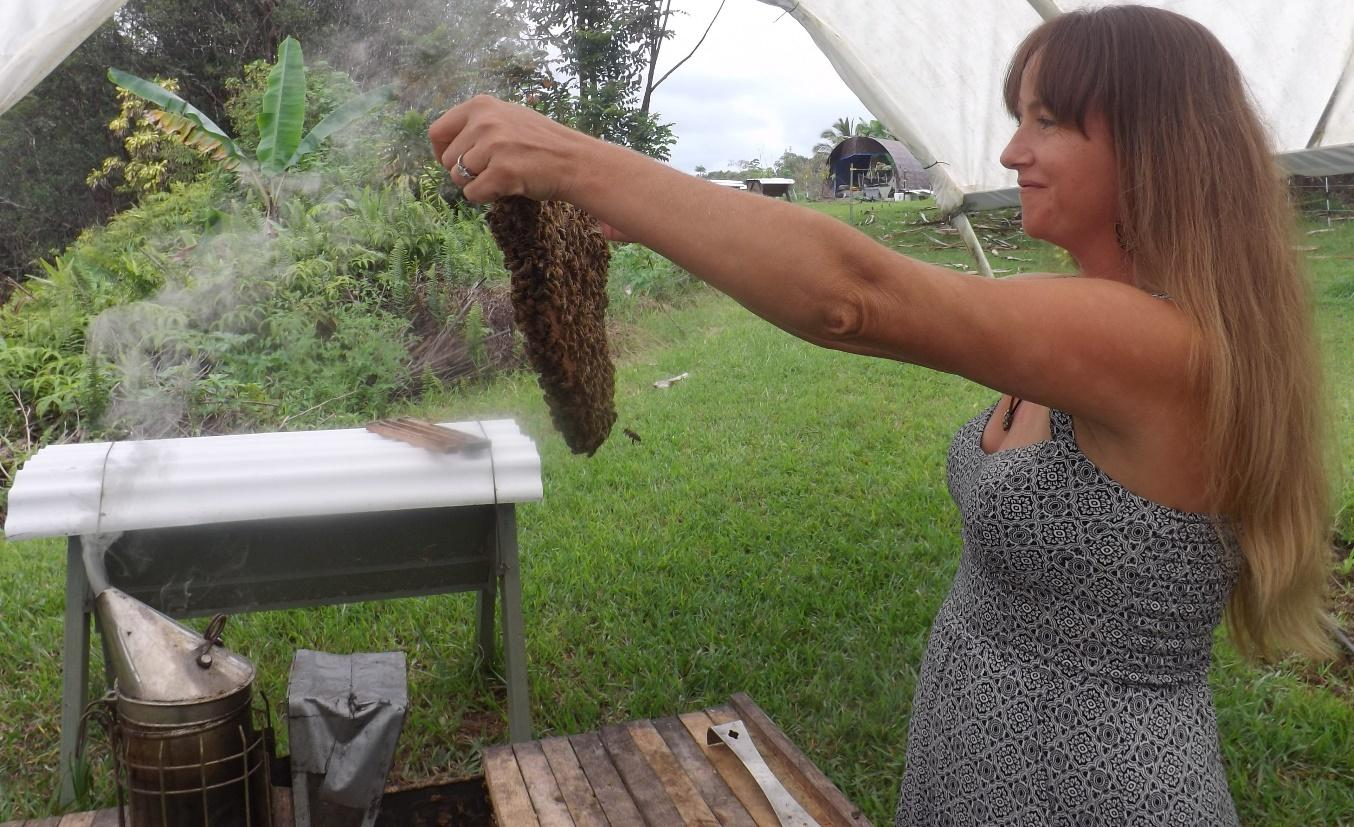
Inspecting a hive. Courtesy of Jen Rasmussen Lair
It is this worry that she translates into her work, choosing action instead of overwhelm.
Her speech for the speechless can be summarized through an excerpt from a poem that she’s written, inspired by the creatures she spends her life working with and the immense challenges she’s watched them endure.
From "Getting Buzzed," by Jen Rasmussen Lair
One day I saw her looking sad & her appearance had changed.
I searched until I found what ailed her,
but I could not stop her pain.
I cried, and did the best I could to ease her troubled hive.
But, I watched her sisters die in vain, from poison & closed minds.
One day she came to me and said:
“I know what you can do, take these seeds, plant these flowers,
& inspire others to do it too.”
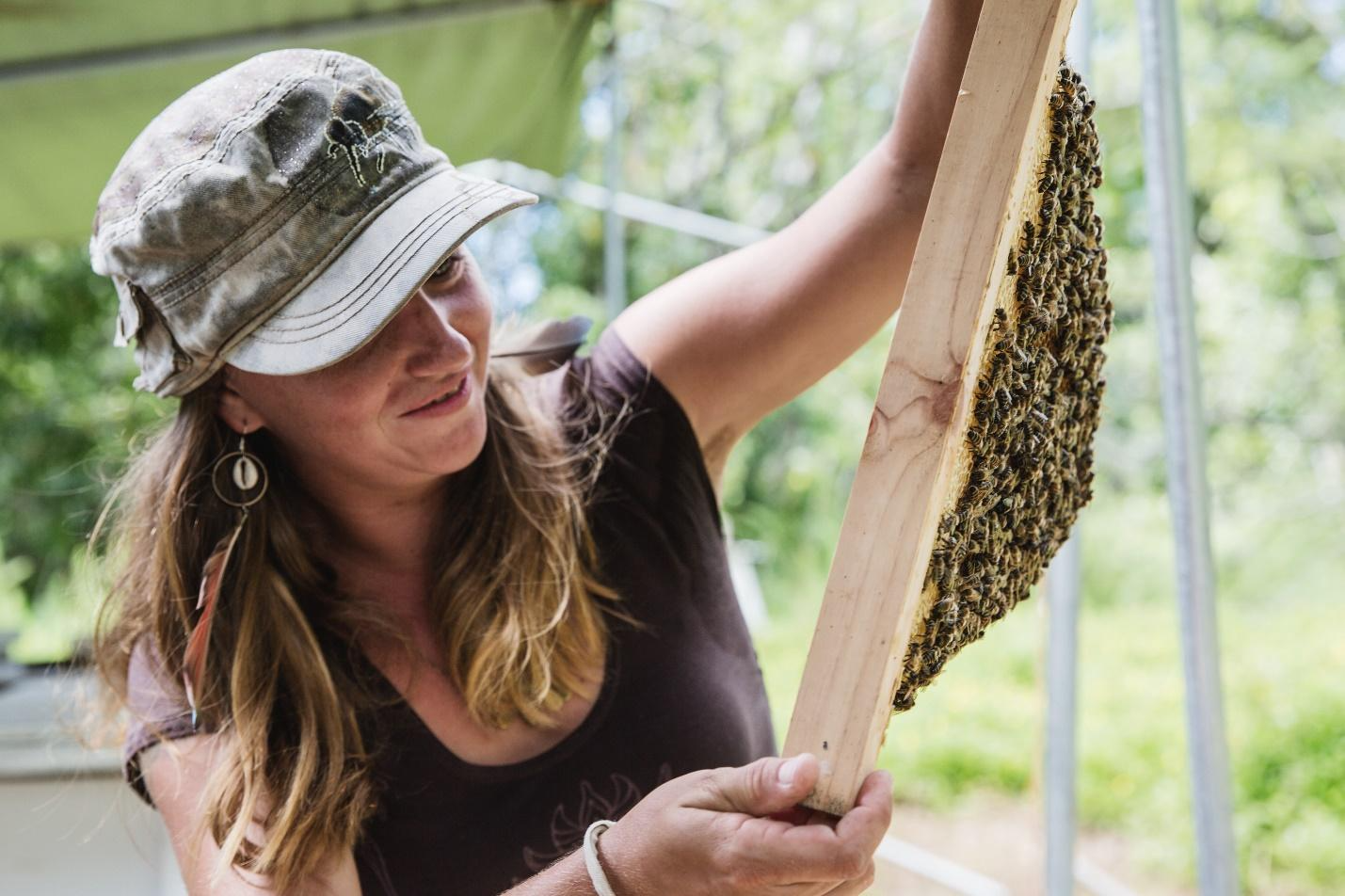
Jen Rasmussen Lair, owner of Paradise Nectar. Courtesy of Jen Rasmussen Lair
Visit Rasmussen Lair and her hives by booking an Airbnb experience next time you’re on the Big Island: airbnb.com/experiences/658416.
Learn more about her methods through her YouTube channel: youtube.com/@ParadiseNectarApiaries96778.
